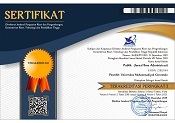STRATEGI PENGELOLAAN ADMINISTRATIF DARI DAMPAK “BALLAST WATER” DI DAERAH BERKEMBANG UNTUK KEBERLANJUTAN KEHIDUPAN MASYARAKAT PESISIR
Abstract
coastal environment and try to give a solution how the administrative management should be done to the
sustainability of coastal society. The method used in writing of this article that is library research from a variety
of sources and based on field observations in some areas with the activity of high boat traffic. Ballast water is
sucked by the pump into the tank ship ballasts are used to maintain the stability of the ship during the cruise,
generally consists of water mixed with various types of marine microorganisms, sediments and rocks. Marine
microorganisms are carried on and switched via ship ballasts tanks will be able to survive in new waters, but life
will change and tend to be predatory. This can cause damage to the food chain and the environment in new
waters. Impact caused by Aquatic Invasive Species (AIS ) on ballast water, Hull and others form part of the ship
of the ecological impact, economic and human health is a common concern this moment especially scientists,
therefore need for appropriate methods in management. Some approaches a comprehensive strategy in the
operational procedures ship, port, ship monitoring inspection, certification, training and education as well as
the roles and responsibilities are clear of the implementing the regulation is an integral part in the effort to
reduce the alien species.
Keywords
Full Text:
PDFReferences
[ABS] American Bureau of Shipping. 2010. Guide for Ballast Water Exchange. Houston. USA
Alekseev V. Makrushin A. Hwang J S. 2010. Does the Survivorship of Activated Resting Stages in Toxic Environments Provide Cues for Ballast Water Treatment?. Elsevier. Marine Pollution
Buletin 61: 254-258
Anderson K. Hulrley W. Reynolds K. Meacham P. 2007. Ballast Water Management in Washington State: A Report of the State Ballast Water Work Group to the 2007 Regular Session of the Washington State Legislature. Puget Sound Action Team. Washington. USA.
Champ M A. 2002. Marine Testing Board for Certification of Ballast Water Treatment Technologies. Pergamon. Marine
Pollution Bulletin 44:1327–1335.
David M. Perkovic M. 2004. Ballast Water Sampling as a Critical Component of Biological Invasions Risk Management.
Elsevier. Marine Pollution Buletin 49:313-318.
Drake L A. Doblin M A. Dobbs F C. 2007. Potential Microbial bioInvasions Via Ships’ Ballast Water, Sediment, and
Biofilm. Elsevier. Marine Pollution Buletin 55:333-341.
Eames I. Landeryou M. Greig A. Snellings J. 2008. Continuous Flushing of Contaminants From Ballast Water Tanks. Elsevier. Marine Pollution Buletin 56:250-260.
Endreson Ø. Behrens H L. Brynestad S. Andersen A B. Skjong R. 2004. Challenges in Global Ballast Water Management. Elsevier. Marine Pollution Buletin 48: 615-623.
Gregg M D. Hallegraeff G M. 2007. Efficacy of Three Commercially Available Ballast Water Biocides Against Vegetative Microalgae, Dinoflagellate Cysts and Bacteria. Elsevier. Harmful
Algae 6:567–584.
Gollasch S. David M. Voigt M. Dragsund E. Hewitt C. Fukuyo Y 2007. Critical Review of The IMO International Convention on the Management of Ships Ballast Water and Sediments. Elsevier. Harmful Algae 6:585-600.
Joachimsthal E L. Ivanov V. Tay S T L. Tay J H. 2004. Bacteriological examination of Ballast Water in Singapore Harbour by Flow Cytometry With FISH. Elsevier. Marine Pollution Buletin 49:334-343.
Karaminas L. Ocakli H. Mazdon H. Westlake P. 2000. An Investigation of Ballast Water Management Methods with
Particular Emphasis on The Risks of The sequential method.
Lloyd_s Register of Shipping. 19pp Lavoie D M. Smitha L D. Ruiz
G M. 1999. The Potential for Intracoastal Transfer of Non-indigenous Species in the Ballast Water of Ships. Estuarine. Coastal and Shelf Science 48:551-564. Lo V. Colin D. Levings.
Simard N. Chan K M A. 2007. Ballast Water and Aquatic
Invasive Species: A Preliminary Estimate of Propagule Pressure for Canadian Ports. Paper. Institute for Resources, Environment and Sustainability at the University of British Columbia. Columbia.
McCollin T. Shanks A M. Dunn J. 2007. The Efficiency of Regional Ballast Water Exchange: Changes in Phytoplankton Abundance and Diversity. Elsevier. Harmful Algae 6:531–546.
McGee S. Piorkowski R. Ruiz G. 2006. Analysis of Recent Vessel Arrivals and Ballast Water Discharge in Alaska: Toward Assessing Ship-Mediated Invasion Risk. Elsevier. Marine Pollution Buletin 52:1634-1645.
Mimura H. Katakura K. Ishida H. 2005. Changes of Microbial Populations in a Ship`s Ballast Water and Sediments on a
Voyage From Japan to Qatar. Elsevier. Marine Pollution Buletin 50:751-757.
Perrins J C. Cooper W J. Leeuwen J. Herwig R P. 2006. Ozonation of Seawater From Different Locations: Formation and
Decay of Total Residual Oxidant— Implications For Ballast
WaterTreatment. Elsevier. Marine Pollution Buletin 52:1023-1033.
Raaymakers S. 2002. The Ballast Water Problem: Global Ecological, Economic and Human Health Impacts. Paper
Presented at the RECSO / IMO Joint Seminar on Tanker Ballast Water Management & Technologies, Dubai,
UAE, 16-18 Dec 2002.
Sherwin L. Cole C. 2005. Spruce Creek Watershed Keystone. Penn State University, University Park Campus.
Tamelander J. Riddering L. Haag F. Matheickal J. 2010. Guidelines for Development of National Ballast Water
Management Strategies. GEF-UNDPIMO GloBallast. London. UK and IUCN, Gland, Switzerland. GloBallast Monographs. No. 18.
Article metrics
Refbacks
- There are currently no refbacks.
Copyright (c) 2015 Mohamad Sayuti Djau

Publik (Jurnal Ilmu Administrasi) is licensed under a Creative Commons Attribution-ShareAlike 4.0 International License.










